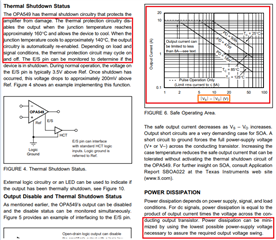- Ask a related questionWhat is a related question?A related question is a question created from another question. When the related question is created, it will be automatically linked to the original question.
This thread has been locked.
If you have a related question, please click the "Ask a related question" button in the top right corner. The newly created question will be automatically linked to this question.
Tool/software:
Used in a circuit with ±24 V supply and 8 A DC current into 1.25 Ω.
It is not known why the thermal shutdown is activated at about 4 A DC.
The fin temperature of the package only rises to about 60°C.
Can the thermal shutdown be triggered before the heat is transferred to the fins?
How should the internal losses be considered?
Hi Kameyama-san,
The fin temperature of the package only rises to about 60°C.
The OPA549's safety of area (SOA) is shown below, abs(Vs) refers to 24Vdc and Vo is the 1.25Ω*4A = 5V. The |Vs|-Vo = 19V, which is dropped across the output stage at any given cycle (PMOS or NMOS driver). Approx. 19V*4A = 76W (if it is operating in DC) is dissipated across the driver stage of the power amplifier, thus Tj will heat up very quickly and thermal shutdown will be activated.
If it is running in AC output, the average power dissipation can be calculated, and it is still high per the SOA chart.

If your output voltage is operating at ±10V @±8A, then the dual supply voltage should be configured at approx. ±10V +/-4.8V ≈ ±15Vdc range. This one the system is able to regulate the output setpoint and current and minimize the heat dissipation.

Of course, if you have a good heat sink and excellent heat transfer efficiency for the OPA549 setup, it may be able to handle a bit more heat dissipation. But the power dissipation can be calculated and simulated to avoid the thermal shutdown.
If you have additional questions, please let me know.
Best,
Raymond